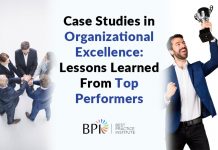High potential employees (HiPOs) increase the value of companies. They are the star performers, the top 10 percenters that keep the business moving forward, providing 90 percent more work, with 20 percent more effort, than non-HiPOs. But once identified, even these superstars require ongoing training to tweak and hone their fine talents and skills. Henry Ford is credited with stating, “The only thing worse than training your employees and having them leave is not training them and having them stay.” Organizations strive to find great talent, but unfortunately, not as many commit the resources to providing continuous development of high-potential employees.
The Impact of HiPOs
A recent Personnel Psychology study titled, “Star Performers in Twenty-First Century Organizations,” found that, in line with the Pareto Principle, across a wide range of organizations, industries, and tasks, a small proportion of the workforce tend to drive a large proportion of organizational results, resulting in the following:
• The top 1% accounts for 10% of organizational output
• The top 5% accounts for 25%, of organizational output
• The top 20% accounts for 80% of organizational output
Locating HiPOs is a little more than half the battle. What remains is providing the nurture, resources, and improvement opportunities to reap the rewards of generous percentages of organizational output.
Finding HiPOs
Definitions for what makes a HiPO varies, but basically it typically boils down to a definition like the one found in the Employee Performance Nine-Box Talent Matrix:
High-potentials are typically defined as those demonstrating high-level contributions, organizational values, potential to move up to an identified position within a given timeframe, and potential to assume greater responsibility.
Some organizations create more foundational descriptions defining high-potential talent as those who are able to assume greater responsibilities within the next two years and who exhibit a history of high-performance and leadership potentials. Or, even more specifically as team members who are able to advance two leadership levels within four to eight years and who score well on various assessment criteria. Whatever the specific criteria is, it is most certainly a description of those individuals who can produce above and beyond the norm and who possess a certain bundle of qualities others don’t, won’t, or can’t obtain.
A Harvard Business Review article describes the indicators one should look for in finding high potential, star performers. The first indicator of potential we look for is the right kind of motivation, but not just plain, vanilla motivation. It must be a fierce commitment to excel in the pursuit of unselfish goals. According to the HBR piece, HiPOs have great ambition and want to leave their mark, but they also aspire to big, collective goals, show deep personal humility, and invest in getting better at everything they do.
Other qualities found in HiPOs include:
• Past performance and initiative for advancement—a track record of success in other companies
• Curiosity—almost to the point of obsession with wanting to know how things work and why, as well as seeking feedback for self improvement
• Engagement—a personality that is persuasive, but not overbearing. Demonstrates almost instant connection with others
• Determination—a stubborn nose-to-the-grindstone doggedness to overcome obstacles and succeed at achieving goals
• Insight—a developed wisdom to digest information and offer alternatives when needed
Developing HiPOs and Early Talent
Once HiPOs are identified, (and the earlier, the better), they, and the organization can benefit from specialized career development plans that ensure those that are the best and brightest quickly rise to the top. Star performers usually know they are stars and will move on to other organizations if they are not first recognized, motivated, and challenged. They tend to see their talents as tools to be honed and utilized and unlike general employees who are satisfied to stay where they are until retirement, HiPOs despise stagnation and will often leave for more rewarding work.
Because HiPOs already recognize that their work style is effective, (or they wouldn’t be considered HiPOs), developing these individuals isn’t necessarily a matter of training in the traditional sense, but of coaching. According to past Best Practice Institute studies, here are three best practices for developing HiPOs and early talent:
• Action Learning—putting employees to work solving real-world business issues. HiPOs, mentors, and other team members are given simulated and real-time issues to solve that relate to their organization.
• Learning Technology—using a combination of synchronous and asynchronous tools and content, can help improve HiPO’s performance and in less time than classroom training. Adaptive learning, virtual reality, and simulation based tools are among some of the most innovative e-learning technologies available today. We shall wait for applications of augmented reality in the future. The more we invest in this technology, the closer we will be to making it an actual “reality” in our workplace.
• Stakeholder-centered Executive Coaching – Stakeholder centered coaching to show changes in behavior over time through supporters and stakeholders never lost its validity. Leaders who enroll stakeholders in the process of helping them achieve their goals win every time because they are able to reduce risk by understanding the perspectives of all people around them.
• Accountability Partnerships – Hi-Pos who have a strong commitment to change must have partners who support their development. Following up with these partners weekly shows the greatest amount of change. According to research by Marshall Goldsmith and Howard Morgan, The more you follow-up with partners, the more you will change – following up only once or twice sometimes shows less change than if you followed up on a consistent and periodic basis.
Retaining HiPOs
After identifying early talent and HiPOs, it is important to continually nurture this wonderful source of high producers. Although they know their potential, they still desire recognition as would any employee. They must not only be identified and developed, but also rewarded as much as possible. Money is a key motivator, but so is being credited with contributing to overall organizational successes.










